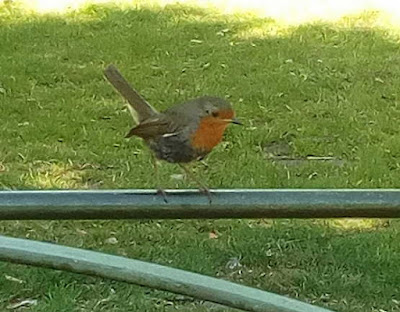Here are a few extracts from books I have read
recently. I keep on thinking how pleased
I am to have my sight back. The time
spent unable to read and see wildlife was horrific. Despite my being reasonably sure that laser
treatment would cure it I found life so boring and frustrating. I am so grateful to all those who sent me
kind thoughts and prayers during that difficult time.
Anthony Berkeley
- “The Poisoned Chocolates Case” (1929)
“He was openly devoted to his wife and did not care
who knew it, while she too, if a trifle
less obviously, was equally said to wear her heart on her sleeve. To make no bones about it, the Bendixes had
apparently succeeded in achieving that eighth wonder of the modern world, a
happy marriage.”
“Joan Bendix was not so serious-minded as not to
have a healthy feminine interest in good chocolates.”
Punch Magazine, 1893
(Sarcastically attacking explorers like Nellie Bly,
Isabella Bird, and Mary Kingsley Amis.)
“A lady, an explorer? A traveller in skirts?
The notion’s just a trifle too seraphic;
Let them stay home and mind the babies, or hem our
ragged shirts
But they mustn’t, can’t, and shan’t be geographic.”
Arthur Conan Doyle – The Adventure of the Second
Stain (1904)
“And yet the motives of women are so inscrutable… How can you build on such a quicksand? Their most trivial action may mean volumes,
or their most extraordinary conduct may depend upon a hairpin or a curling
tongs.”
R Austin Freeman – The Aluminium Dagger (1909) reprinted in “Miraculous
Mysteries”, ed. Martin Edwards
“The scared rite of the ‘tub’ had been duly performed. And the freshly dried person of the present narrator was about to be insinuated into the first installment of clothing, when a hurried step was heard upon the stair…”
Draft of a talk by Dorothy L Sayers (first published
1978)
“But when all is said, it is by the writing that
every work of literature must in the long run stand or fall, and Trent’s Last
Case is supremely well written without ever straying too far from the plot or
getting out of key with the general tone of the book; the style ranges from a
vividly coloured rhetoric to a delicate and ironical literary fancy. Now touching on the greater issues of human
life, now breaking into a ripple of comment on arts and letters, running into
little sidestreams of wit and humour, or spreading into crystal pools of beauty
and tender feeling, Trent’s Last Case welled up in the desiccated desert of
mystery fiction like a spring of living water.
No other writer had ever handled that kind of theme with so light and
sure a hand.”
E C Bentley – “Trent’s Last
Case” (1913)
“The great thing about a
hotel sitting-room is that its beauty does not distract the mind from
work. It is no place for the may-fly
pleasures of a mind at ease. Have you
ever been in this room before, Cupples?
I have, hundreds of times. It has
pursued m all over England for years. I
should feel lost without it if, in some fantastic, far-off hotel they were to
give me some other sitting-room. Look at
this table-cover; there is the ink I spilt on it when I had this room in
Halifax. I burnt that hole in the carpet
when I had it in Ipswich. But I see they
have mended the glass over the picture of ‘Silent Sympathy’ which I threw a
book at in Banbury. I do all my best
work here.”
Susan Barker – “Incarnations” (2015)
“She has a personality like fingers on a chalkboard., setting his nerves on edge.”






































































































